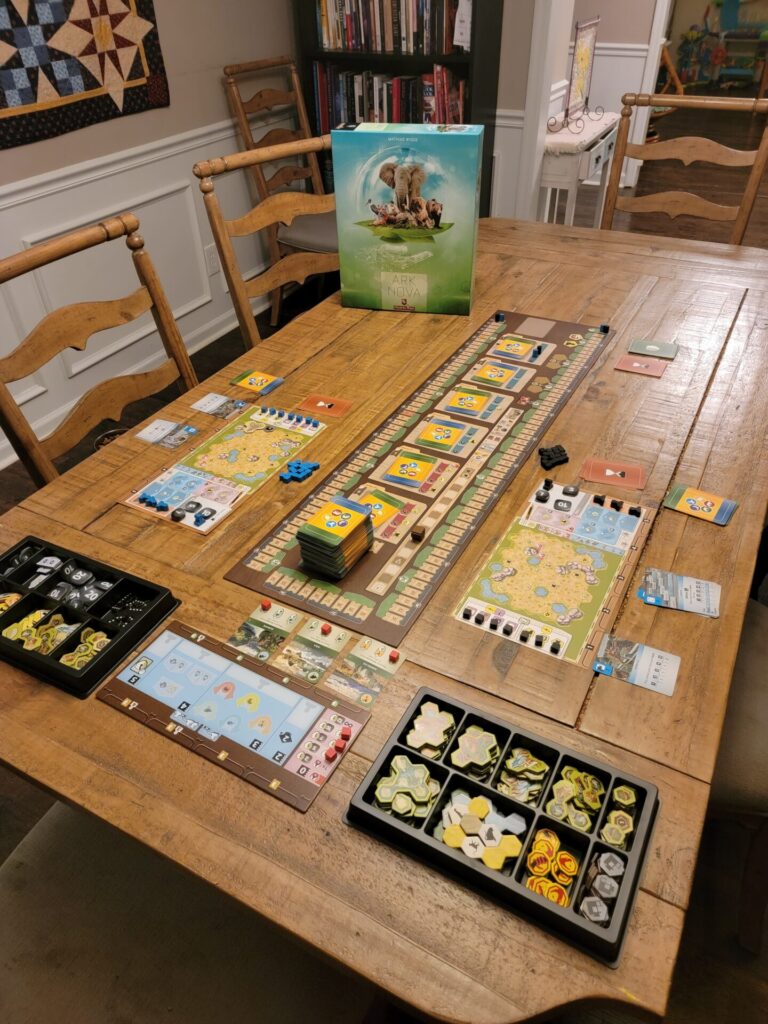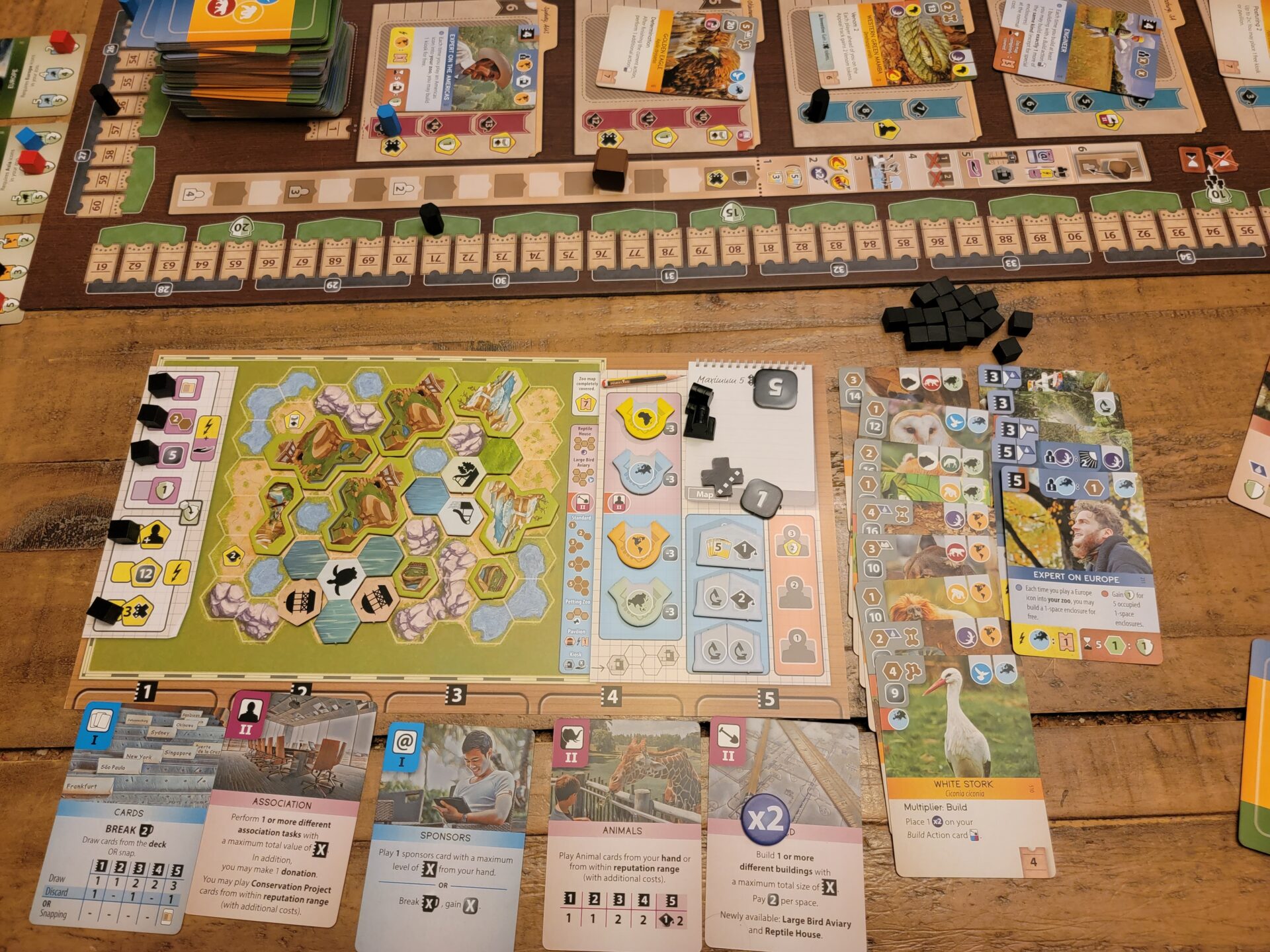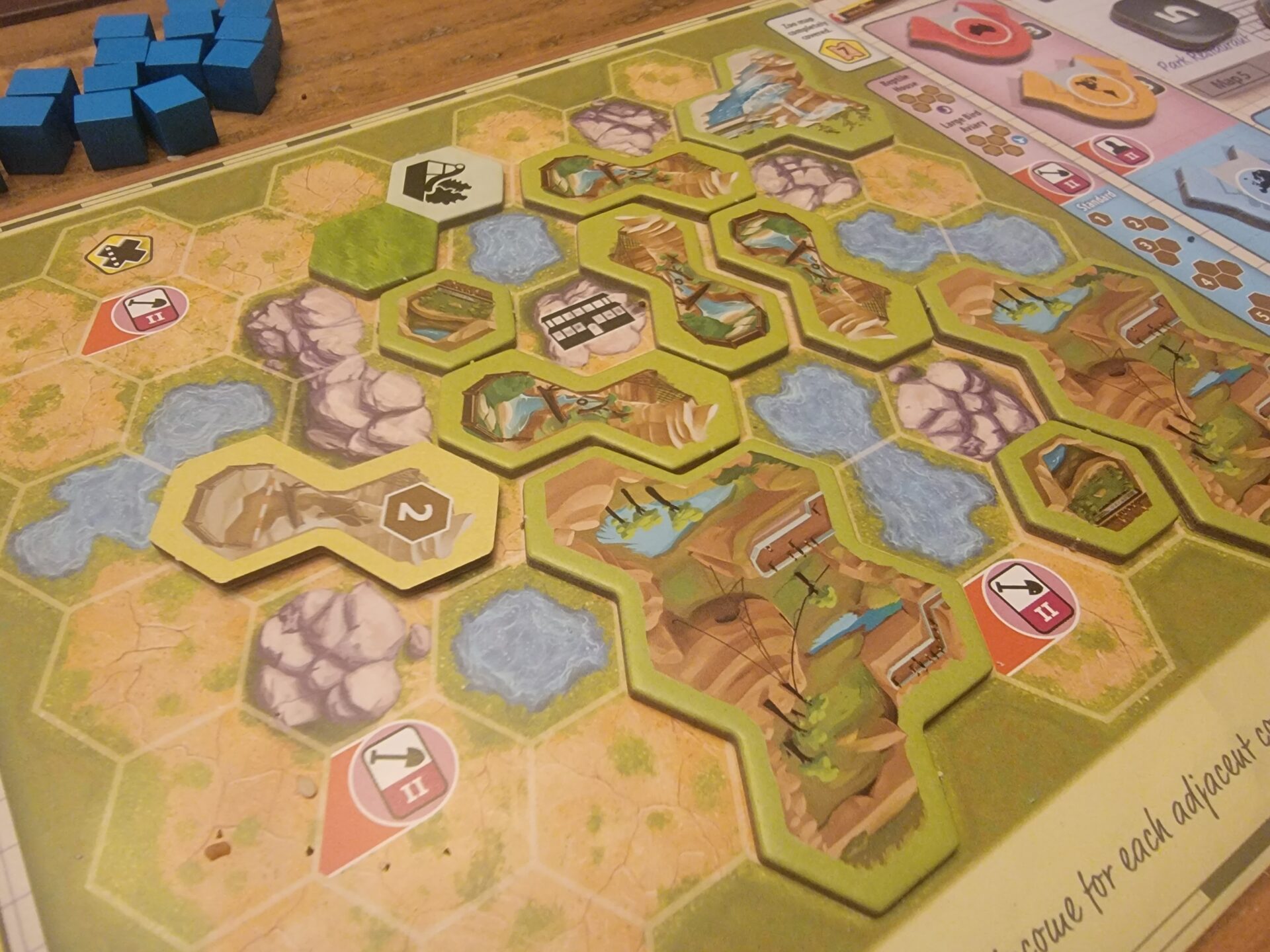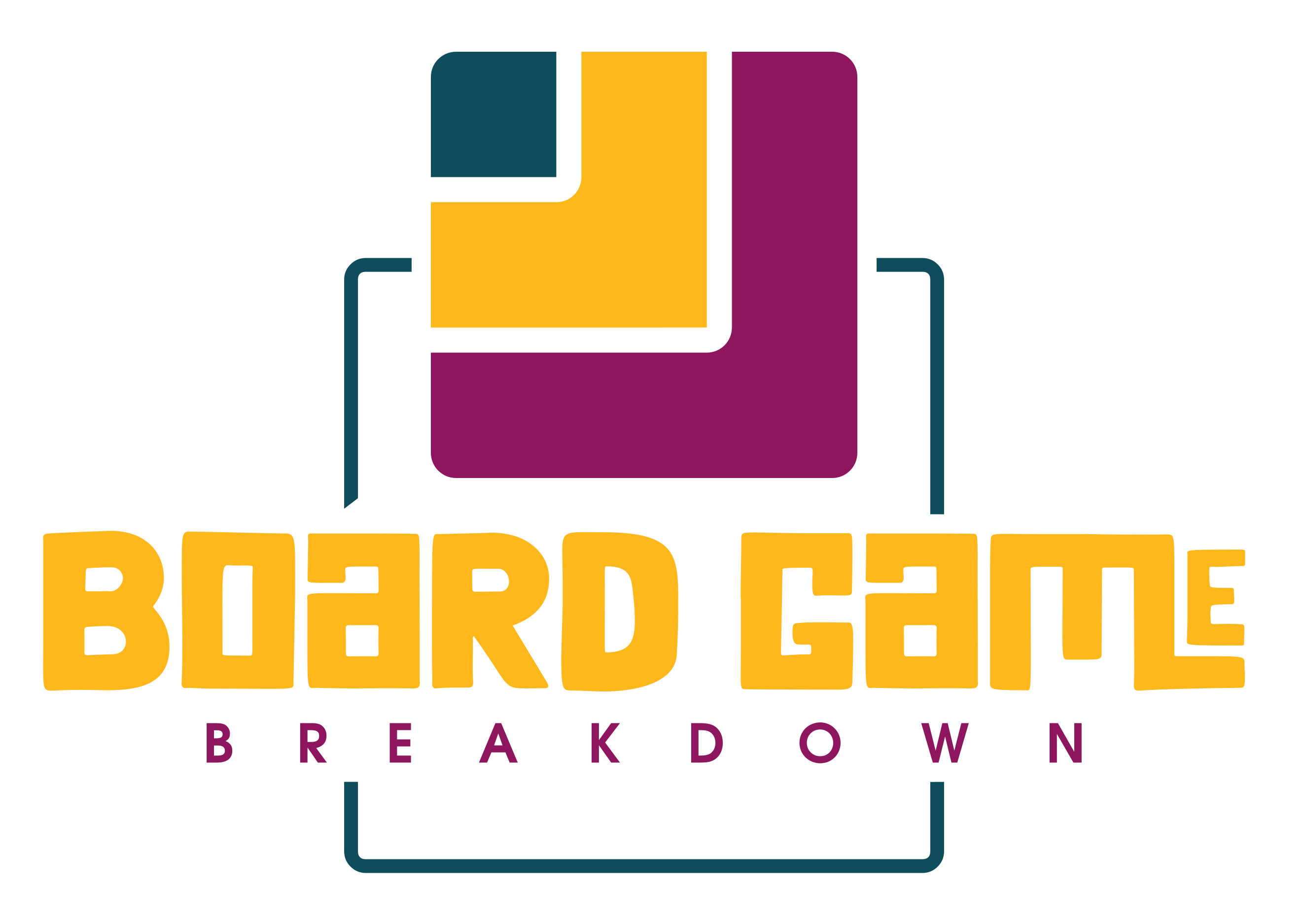
Name: Ark Nova
Year of Release: 2021
Player Count: 1 – 4
Playing Time: 90 – 150 Minutes
Designer: Mathias Wigge
Publisher: Capstone Games
Primary Mechanisms: Open Drafting, Hand Management, Tile Placement
Weight (According to BGG.com): 3.71
Overview
It has been nearly 10 years since I first registered on the massive board game database, BoardGameGeek.com, and I don’t think I’ve ever seen a game have such a meteoric rise up the charts as Ark Nova has had. Honestly, the constant talk about it created this strange experience for me where I was curious enough in it to put it on my “wish list,” but looking into it any further than that, held no interest to me. I would see the name as I scrolled through different websites or notice people arguing about how much they loved (or despised it) as I read through varying forums, but it didn’t take up too much space in my brain.
Lo, and behold, one of the gifts I opened on Christmas morning from my wife was a huge box with a stunning array of animals printed on it. I was then confronted with the realization that I had just been gifted a game that I really knew nothing about. It was a feeling of both excitement and dread. Knowing it had a hefty price tag, how would I feel if it wasn’t a hit? Probably bad. Should I have paid more attention to all those people discussing it earlier this year? Probably yes. But all the worrying was for naught as I absolutely love the game and as a plus, so does my wife! Read on to get the details of why I am totally buying into all the hype of Ark Nova.
Rulebook & Components
With a game of Ark Nova’s weight, players should expect an informative and detailed rulebook, and that is exactly what they will receive here. There is the standard rulebook, plus a nice Glossary add on that goes into specifics on various cards, and then a double-sided Icon Review Sheet for quick reference. I love when game designers include the Glossary books, especially when there are large amounts of different powers on different cards. It has come in handy multiple times when we have come across a card that has an uncommon ability and we are able to quickly reference it in the Glossary. The Glossary is split up conveniently by the different card types, so everything is able to be found rapidly.
The standard Rulebook is easy to follow and laid out in a manner that gets players up and running through a normal turn fairly quickly. Tucked in the back, there are instructions on how to play the Solitaire variant, which isn’t much different from the multiplayer version, so they only needed to dedicate a few pages to it. I will say that one mechanism (Releasing Animals) felt like it got a little lost in the Rulebook and the first few times we needed to do it, we were hard pressed to find exactly how this portion of the game works. But for a game this size, with this many moving parts, I’m surprised how easily I’ve found answers to all of my questions as I’ve been playing.
The components make for a striking presence on your table, though if you have a smaller table, good luck getting it all on there. If you’re not a fan of games with multiple boards, you might not like this either as you have a main board that holds cards and various tracks, each player’s personal Zoo Board, and a separate shared Association Board. Taking up residence on the majority of these boards are all sorts of wooden tokens and cardboard chits/tiles. Thankfully, the game comes with two large rectangular Organizers that are a life saver when packing the game back into the box.
Lastly, on the component side of things, you have the massive deck (212!) of Zoo Cards. These cards include Animals, Sponsors, and Conservation Projects. Each is emblazoned with a beautiful life-like painting of said subject, and icons galore. I realize that some players are going to be put off by the realistic artwork, feeling the creators just slapped some lazy stock photos on the cards and called it a day, but I think the design works in this setting. For the iconography’s part, it does it’s best to be concise and intuitive, but some cards just have so many icons on them, a new player (and maybe even some experienced ones) are going to feel overwhelmed. There are icons in the right corner that mean one thing, but then if they are on the left side with a red banner, they might mean another or if they’re on the left side with no red banner, they are used as tags to influence other cards. One icon might mean you take the action immediately, another means you only do so during the Income phase, another means it’s active all the time. If you’ve played any other heavy modern board game, this is going to be no surprise to you and you will pick it up quickly, but for those that have seen this game hyped up and think it might be for everyone, just realize, Wingspan it is not.
Setup

When I busted the box open on Christmas day, I was first overjoyed to see how many tokens I was going to get to punch out of the numerous punchboards. Quickly the joy turned to a feeling of nervousness as I realized that this game was going to be a bear (haha, get it?) to setup and tear down. I was actually really wrong about this assumption. Thanks to those aforementioned organizers, most of the tokens are just going to stay in their little rectangular homes until called upon during gameplay.
The main board is placed in the middle of the play area and three tokens per player are placed on their specific trackers (Appeal, Conservation, and Reputation.) Zoo Cards are shuffled and eight are passed out to each player and then six are placed face-down on the main board. The individual Zoo Boards are all double-sided, some sides are identical and intended for novice players, and others are asymmetrical, giving players a different ability to use during gameplay. Once each player is given a Zoo Board, they place their Worker tokens and Money on the correct areas, along with some Cubes covering up certain abilities that can be unlocked later in the game. Lasty, the Association Board is placed to the side and filled with both Partner Zoo Tokens and Academic Tokens.
Once these boards are all setup, two Final Scoring Cards and five Action Cards are passed to each player and a specific amount of Base Conservation Project Cards are placed below the Association Board. Players then choose to keep four of the eight Zoo Cards they were given and discard the rest. After all players make this choice, the six Zoo Cards placed on the main board can be flipped over, revealing what they are, and the game can begin!

Unlike a lot of games, Ark Nova does not take place over a certain number of rounds. Instead, certain actions cause a Break Token to move down a track, and once it reaches the end, a phase is triggered where players receive Income, reset their Workers, and discard down to a certain number of cards in their hands. The Break Token is then moved back to its original position and play continues.
On a players turn, there are five different actions they can choose, each represented by a different Action Card placed in one of the five slots at the bottom of their individual Zoo Boards. Each slot is numbered one to five, from left to right. These numbers represent the amount of power that action will have when used, meaning the cards further to the right are more powerful than their counterparts to the left. When an action is taken, that card is moved to the far left and all cards that were originally to the left of this card, slide to the right one spot. In addition, players can secure X Tokens that will help them boost the power of each card so if they have an action in the second spot, but they really need it to have a power of four, they could still play this card and turn in two X Tokens to create the total of four. I really love this “rondel” type system, as it gives the player a ton of flexibility on each turn but still has a slight limiting factor to create meaningful decisions.
The five actions are as follows:
- Play Animal Cards: allows players to spend money to build their Zoo Tableau by playing cards, generally gaining more Appeal and abilities
- Build Enclosures: enables players to place Enclosure Tiles on their Zoo Board in order to hold the animals represented by the Animal Cards mentioned above
- Play Sponsor Cards: allows players to place Sponsors into their Zoo Tableau. These do not cost money and typically give bonuses that help the player throughout the rest of the game.
- Association Board: gives the players a chance to put available Workers on the Association Board, triggering different effects such as gaining Reputation or completing Conservation Projects, thus increasing their Conservation track.
- Draw Cards: draw a certain number of cards from either the deck or the Reputation Row on the board
Through these actions, players will be building both their Zoos as well as their tableaus, attempting to gain both Appeal and Conservation points. These two tracks are found on the outside of the main board, each progressing in opposite directions. Once a player’s two markers cross each other, the endgame is triggered and all other players get one more turn. Final Scoring Cards and any bonus end-game actions are triggered (typically increasing one’s Conservation points) and then final scores are determined.
Conclusion

Ark Nova is the perfect game for me. It does have a lot of detractors because of supposed “multiplayer solitaire” but this doesn’t bother me that much. I don’t really care for “take that” games so the level of interaction in Ark Nova is fine by me. There have been times when my opponent has taken a certain tile on the Association Board away from me or when they’ve caused a Break at an inopportune time. These bits of interaction are enough for me but I understand that some players might not feel the same.
Another thing I like about Ark Nova is the “race” aspect. Yes, the game looks like an engine builder but I believe at its core, it is truly a race for a player to get their Appeal and Conservation markers to meet. This adds a level of urgency to each turn, especially as the game goes, that I really enjoy. This does introduce one con though, as in most of my plays so far, the “rich get richer” and it is challenging to catch up once you’re down. This might have more to do with my apparent lack of skill at this game (as my wife as beaten me every time) so I won’t hold it against the game too much.
Altogether, this game lives up to the hype for me and my playgroup. It fills a nice space for us in that it is heavy enough to be rewarding but not so much that you get bogged down in minutiae. For the foreseeable future, I’ll be visiting this zoo as much as possible!
Rating
Ratings are based on 5 main criteria: rulebook, setup, components, art & graphic design, and gameplay. The first 4 criteria are rated 1 to 5 and the gameplay is rated 1 to 10. These scores culminate in an “overall satisfaction” score that is rated from 1 to 10. If the reviewed game has both a solo and multiplayer mode, I have assigned scores separately to give context to which mode we enjoy more.
Links
As an Amazon Associate I earn from qualifying purchases.
Amazon: Ark Nova Board Game
